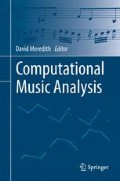Abstract
This chapter examines questions of what is to be analysed in computational music analysis, what is to be produced, and how one can have confidence in the results. These are not new issues for music analysis, but their consequences are here considered explicitly from the perspective of computational analysis. Music analysis without computers is able to operate with multiple or even indistinct conceptions of the material to be analysed because it can use multiple references whose meanings shift from context to context. Computational analysis, by contrast, must operate with definite inputs and produce definite outputs. Computational analysts must therefore face the issues of error and approximation explicitly. While computational analysis must retain contact with music analysis as it is generally practised, I argue that the most promising approach for the development of computational analysis is not systems to mimic human analysis, but instead systems to answer specific music-analytical questions. The chapter concludes with several consequent recommendations for future directions in computational music analysis.
Access this chapter
Tax calculation will be finalised at checkout
Purchases are for personal use only
Preview
Unable to display preview. Download preview PDF.
References
Anglade, A., Benetos, E., Mauch, M., and Dixon, S. (2010). Improving music genre classification using automatically induced harmony rules. Journal of New Music Research, 39(4):349–361.
Bent, I. (1987). Analysis. Macmillan.
Byrd, D. (1984). Music notation by computer. PhD thesis, Indiana University.
Byrd, D. (2013). Gallery of interesting music notation. http://homes.soic.indiana.edu/donbyrd/InterestingMusicNotation.html.
Downie, J. S. (2008). The music information retrieval evaluation exchange (2005- 2007): A window into music information retrieval research. Acoustical Science and Technology, 29(3):247–255.
Dunsby, J. (1982). Editorial. Music Analysis, 1(1):3–8.
Goehr, L. (2007). The Imaginary Museum of Musical Works: An Essay in the Philosophy of Music. Oxford University Press, second edition.
Good, M. (2001). MusicXML for notation and analysis. In Hewlett, W. B. and Selfridge-Field, E., editors, The Virtual Score: Representation, Retrieval, Restoration, volume 12 of Computing in Musicology, pages 113–124. MIT Press.
Goodman, N. (1976). Languages of Art: An Approach to a Theory of Symbols. Hackett, second edition.
Hamanaka, M., Hirata, K., and Tojo, S. (2006). Implementing “A Generative Theory of Tonal Music”. Journal of New Music Research, 35(4):249–277.
Keller, H. (1965). The chamber music. In Robbins Landon, H. and Mitchell, D., editors, The Mozart Companion, pages 90–137. Faber.
Keller, H. (1985). Functional analysis of Mozart’s G minor quintet. Music Analysis, 4(1/2):73–94.
Lerdahl, F. and Jackendoff, R. (1983). A Generative Theory of Tonal Music. MIT Press.
Levinson, J. (1980). What a musical work is. Journal of Philosophy, 77(1):5–28.
Marsden, A. (2010). Schenkerian analysis by computer: A proof of concept. Journal of New Music Research, 39(3):269–289.
Mawer, D. (1999). Bridging the divide: embedding voice-leading analysis in string pedagogy and performance. British Journal of Music Education, 16(2):179–195.
McVicar, M., Ni, Y., Santos-Rodriguez, R., and De Bie, T. (2011). Using online chord databases to enhance chord recognition. Journal of New Music Research, 40(2):139–152.
Meredith, D. (2007). Computing pitch names in tonal music: A comparative analysis of pitch spelling algorithms. PhD thesis, Faculty of Music, University of Oxford.
Meredith, D. (2012). Music analysis and Kolmogorov complexity. In Proceedings of the 19th Colloquio di Informatica Musicale (XIX CIM), Trieste, Italy.
Meredith, D. (2015). Music analysis and point-set compression. Journal of New Music Research, 44(3). In press.
Nattiez, J.-J. (1982). Varèse’s ‘Density 21.5’: A study in semiological music analysis. Music Analysis, 1(3):243–340.
Nattiez, J.-J. (1990). Music and Discourse: Towards a Semiology of Music. Princeton University Press.
Pauwels, J. and Martens, J.-P. (2014). Combining musicological knowledge about chords and keys in a simultaneous chord and local key estimation system. Journal of New Music Research, 43(3):318–330.
Pearce, M. andWiggins, G. (2012). Auditory expectation: The information dynamics of music perception and cognition. Topics in Cognitive Science, 4(4):625–652.
Pople, A., editor (1994). Theory, Analysis and Meaning in Music. Cambridge University Press.
Réti, R. (1962). The Thematic Process in Music. Macmillan.
Réti, R. (1967). Thematic Patterns in the Sonatas of Beethoven. Faber.
Samson, J. (1999). Analysis in context. In Cook, N. and Everist, M., editors, Rethinking Music, pages 35–54. Oxford University Press.
Sapp, C. (2014). 371 Four-part Chorales by J.S. Bach in the Humdrum file format. https://github.com/craigsapp/bach-371-chorales.
Sleator, D. and Temperley, D. (2003). The Melisma music analyzer. http://www.link.cs.cmu.edu/melisma/.
Sturm, B. L. (2014). The state of the art ten years after a state of the art: Future research in music information retrieval. Journal of New Music Research, 43(2):147–172.
Temperley, D. and VanHandel, L. (2013). Introduction to the special issue on corpus methods. Music Perception, 31(1):1–3.
van Kranenburg, P. (2008). On measuring musical style—The case of some disputed organ fugues in the J. S. Bach (BWV) catalogue. Computing in Musicology, 15:120–137.
Whorley, R. P., Wiggins, G. A., Rhodes, C., and Pearce, M. T. (2013). Multipleviewpoint systems: Time complexity and the construction of domains for complex music viewpoints in the harmonization problem. Journal of New Music Research, 42(3):237–266.
Author information
Authors and Affiliations
Corresponding author
Editor information
Editors and Affiliations
Rights and permissions
Copyright information
© 2016 Springer International Publishing Switzerland
About this chapter
Cite this chapter
Marsden, A. (2016). Music Analysis by Computer: Ontology and Epistemology. In: Meredith, D. (eds) Computational Music Analysis. Springer, Cham. https://doi.org/10.1007/978-3-319-25931-4_1
Download citation
DOI: https://doi.org/10.1007/978-3-319-25931-4_1
Published:
Publisher Name: Springer, Cham
Print ISBN: 978-3-319-25929-1
Online ISBN: 978-3-319-25931-4
eBook Packages: Computer ScienceComputer Science (R0)

